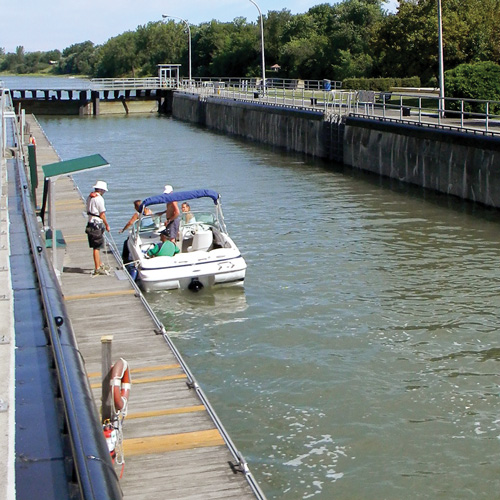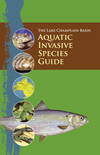AIS Threats
A number of aquatic invasive species are “on the doorstep” of Lake Champlain. Waterways in the regions around the Lake contain significant numbers of invasive species. Round goby, Asian clam, hydrilla, and others are poised to enter from the Great Lakes, Hudson River, and St. Lawrence River via canals and tributaries. Invasive species could be introduced easily by release of live bait, aquarium dumping, hitchhiking on boats and trailers, or intentional stocking.
For many of these species, preventing their introduction to the Lake Champlain Basin is critical. Extermination or spread prevention of established invasive species is often expensive and difficult, if not impossible. For this reason, the LCBP and partners have made education about AIS spread prevention a priority. The Lake Champlain Basin Aquatic Invasive Species Identification Guide provides important information about how to identify aquatic invasive species and how to report a finding to proper resource managers.
Several species that have not yet been found in Lake Champlain but could have significant impacts if introduced are high priority species for prevention in the 2005 Lake Champlain Basin Aquatic Nuisance Species Management Plan.
- Eurasian ruffe
- Hydrilla
- Quagga Mussels
- Round Goby
- Viral Hemorrhagic Septicemia (not in plan, but identified as species of concern)
Eurasian Ruffe
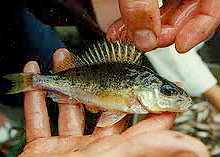
The Eurasian ruffe (Gymnocephalus cernuus) was first found in Lake Superior in 1986 and has since expanded its population and range substantially. It is a perch-like fish native to Eurasia that usually grows no longer than six inches.
Ruffe threaten the sport fish population of Lake Champlain by preying on their eggs and competing for food and habitat. They mature quickly, have high reproductive potential, and are adaptable to a wide variety of habitats, due in part to their tolerance of poor water conditions. Studies have shown decreases in native fish populations where ruffe populations have established.
More on Ruffe
- Ruffe Fact Sheet (Minnesota Sea Grant)
- Ruffe Fact Sheet & Distribution Map (USGS)
- Ruffe Fact Sheet (Army Corp of Engineers)
Hydrilla
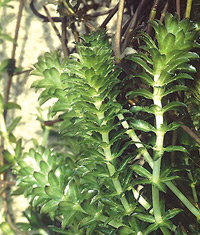
Hydrilla (Hydrilla verticillata) is a nonnative aquatic plant that is spreading across fresh waters of the northeast. Hydrilla was first introduced to the United States as a popular aquarium plant, which was then accidentally released into the wild in Florida. It is a federally listed noxious weed.
Hydrilla has been confirmed in Connecticut, Massachusetts, Maine, and New York. Hydrilla poses a serious threat to the waters of the Lake Champlain Basin. Hydrilla is well established in the Erie Canal and the Cayuga Inlet in NY and could move through the Champlain Canal system into Lake Champlain.
Hydrilla spreads rapidly, is adaptable to a variety of habitats, and is very difficult to control once a viable population is established. It is capable of completely clogging waterways. Its vertical branches often out-compete native plants, affecting water quality and restricting flow. The widespread growth of this plant has dramatic impacts on recreational uses such as boating, fishing, and swimming.
More on Hydrilla
- New York Invasive Species Information
- Hydrilla Fact Sheet (University of Florida)
- Hydrilla Fact Sheet & Distribution Map (USGS)
- Hydrilla Biological Control Options (University of Georgia / USDA)
- Hydrilla Library (Cornell Cooperative Extension)
- Hydrilla Treatment in the Connecticut River webpage and fact sheet (U.S. Army Corps of Engineers)
Quagga Mussels
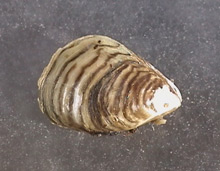
Quagga mussels (Dreissena bugensis) are native to the Caspian Sea area. They were first introduced to the Great Lakes in 1989 and can now be found throughout the Great Lakes, the St. Lawrence River, Erie Canal and in a few inland water bodies in New York. Quagga mussels pose many of the same threats to the Lake Champlain Basin as zebra mussels.
The quagga mussel is a close relative of the zebra mussel, but scientists believe that it poses a greater threat. Quagga mussels are able to colonize a wider variety of lake bottom surfaces than zebra mussels and are more tolerant of a greater range of temperatures, depth, and other environmental conditions. In the Great Lakes, quagga mussels already out-compete and have replaced zebra mussels in greater numbers, resulting in more substantial negative impacts. Quagga mussels have the potential to significantly amplify the negative impacts currently caused by zebra mussels in Lake Champlain and must be monitored carefully to prevent infestation.
More on Quagga Mussels
Round Goby
Native to Europe, the round goby (Neogobius melanostomus) was first found in the St. Clair River in 1990 and has subsequently expanded its distribution to many areas of the Great Lakes, Erie Canal, the interior of New York, and the St. Lawrence and Richelieu Rivers in Quebec. The goby is gray, four to ten inches in length, and is physically similar to other species native to US waters.
The round goby out-competes native species for food and habitat by feeding at night, thriving in poor water conditions, spawning multiple times a season, and preying on native eggs and young. It has already substantially affected recreational and commercial fisheries in the Great Lakes, resulting in seasonal restrictions on certain types of fish whose populations have been reduced by goby. While the round goby is known to eat zebra mussels, they do not eat them in great enough number to affect the population. The introduction of the round goby to Lake Champlain could dramatically impact the Lake’s game fish.
More on Round Goby
- Uninvited: The Round Goby (Lake Champlain Basin Program)
- Round Goby Fact Sheet (Great Lakes Commission)
- Round Goby Fact Sheet & Distribution Map (USGS)
- Round Goby Taxonomy & Fact Sheet (Columbia University)


